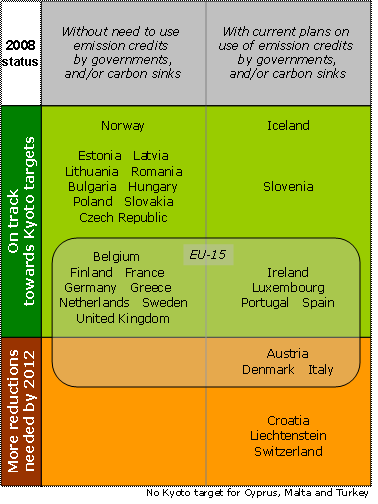The EEA report 'Tracking
progress towards Kyoto and 2020 targets' presents an overview of the progress
actually seen in 2008 (and 2009 where data are available) in European countries
towards their respective targets under the Kyoto Protocol. Based on aggregated
emission projections at EU level, the report also presents an assessment of
projected progress of the EU-15 towards its 8 % reduction commitment and
of the EU-27 towards its 20 % reduction target by 2020.
'We cannot afford to wait until after the end of
the Kyoto
period to start implementing policies targeting sectors not covered by the
EU ETS, such as transport and residential heating. These sectors are crucial for the EU targets set for 2020,' said
Professor Jacqueline McGlade, Executive Director of the EEA.
Key findings
- When looking at 2008 and 2009, the two first
years of the Kyoto
commitment period, the EU-15 appears to be well on track towards achieving its commitment
of reducing emissions by 8 % compared to base-year levels. Together, the EU-15 countries are estimated to have reduced their average
annual emissions over these two years by more than 250 million tonnes CO2
equivalent beyond the reductions needed for achieving their common Kyoto target. This puts
EU-15 collectively 5.9 % below the 8 % Kyoto reduction target. The figures take
into account the planned use of the Kyoto Protocol’s flexible mechanisms by
governments (2.7 % of base-year emissions) and the expected sequestration
of atmospheric carbon due to forestry activities (1.0 % of base-year
emissions). However, failure by any EU-15 Member State to achieve its own
burden-sharing target could jeopardize the possibility for the EU-15 to achieve
its common target.
-
Current emission
levels and projections show that the EU is well on track towards achieving its
2020 reduction target of 20 % with emission reductions achieved in the EU
territories only, provided that Member States fully implement the Climate and
Energy package adopted in 2009. Recent estimates
by the EEA also confirm this downward trend, with the EU-27’s 2009
emissions expected to stand 17.3 % below their 1990 level.
- Based on their
2008 emission levels, almost all European countries with a Kyoto target were on track to meet their
individual targets. However, three EU Member States (Austria,
Denmark and Italy), two other EEA countries (Liechtenstein and Switzerland)
and one EU candidate country (Croatia)
need to step up their efforts before 2012 to be able to meet their targets.
- Because the allocation
of emission allowances to the EU ETS is already decided upon for the full
period 2008–2012, reducing emissions in the sectors not covered by the EU ETS
– such as transport, residential heating, agriculture or waste – are necessary for
achieving the Kyoto
targets.
-
The economic crisis largely contributed to the
drop in total EU-27 greenhouse gas emissions in 2009 compared to 2008 (by 6.9 %
according to EEA
estimates), but its impact was felt less significantly in the sectors not included
in the EU ETS (– 3.3%) than in the sectors included (– 11.7 %).
Return to economic growth could temporarily level off or even reverse the
decline in emissions, but the declining trend is expected to continue.

Notes to the editor
The EEA report 'Tracking
progress towards Kyoto
and 2020 targets' can be found at http://www.eea.europa.eu/publications/progress-towards-kyoto/.
The European Commission also publishes a report today assessing the
EU's progress towards the Kyoto commitments, which takes into account actual
emissions and projections to the end of the 2008-2012 commitment period, whereas the EEA report is based on actual
emissions in 2008 (and 2009 where data are available). As such, the two reports
complement each other.
The EEA's report will be followed later in the year by an
in-depth analysis of the links between historic emission trends and the
policies and measures implemented in the EU.
Background on EU emission reduction commitments
Under the Kyoto Protocol, the EU-15 has a common commitment
to reduce emissions on average by 8 % between 2008 and 2012 compared to
emissions in the 'base year' (mostly 1990). Unlike the EU-15, the EU-27 does
not have a common target under the Kyoto Protocol and therefore the EU-27 does
not have an applicable base year against which to compare emission changes.
Emission changes compared to 1990 are relevant for the EU-27 as it has made a
unilateral commitment to achieve at least a 20 % reduction of greenhouse
gas emissions by 2020 compared to 1990.
About the European Environment Agency (EEA)
The EEA is based in Copenhagen.
The Agency aims to help achieve significant and measurable improvement in Europe’s environment by providing timely, targeted,
relevant and reliable information to policymakers and the public.
EEA member countries: Austria, Belgium, Bulgaria, Cyprus,
the Czech Republic, Denmark, Estonia, Finland, France, Germany, Greece,
Hungary, Iceland, Ireland, Italy, Latvia, Liechtenstein, Lithuania, Luxemburg,
Malta, the Netherlands, Norway, Poland, Portugal, Romania, Slovak Republic,
Slovenia, Spain, Sweden, Switzerland, Turkey, the United Kingdom.
Contact information
For media
inquiries:


Document Actions
Share with others